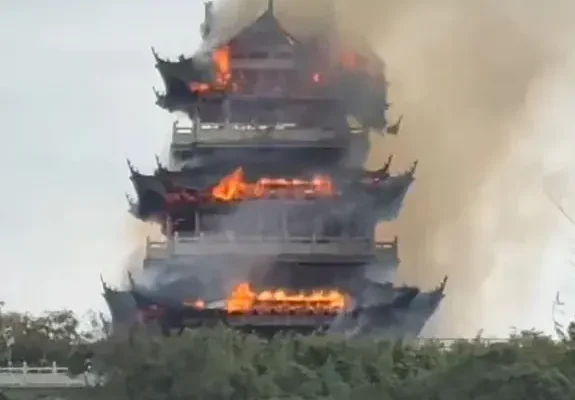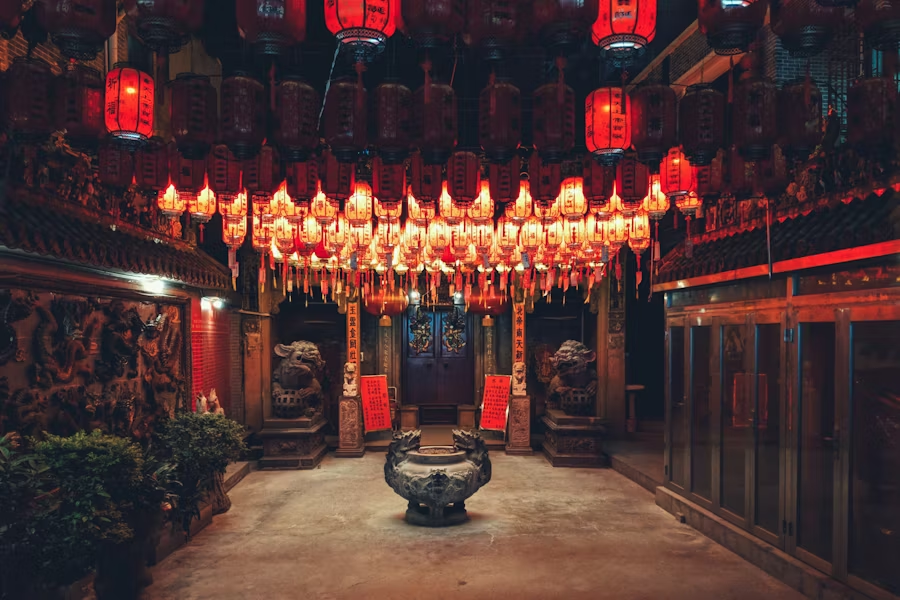
What began as an ordinary, peaceful morning on Fenghuang Mountain in Jiangsu Province quickly transformed into a scene of fear, disbelief, and irreversible loss. A tranquil cultural site—visited daily by worshippers, hikers, and tourists—was suddenly engulfed in flames after a visitor’s careless act triggered a massive blaze at one of the region’s most cherished structures: the Wenchang Pavilion.
The incident, which occurred just after 11:00 a.m. local time, has captured nationwide attention, not only for the scale of the destruction but also for the underlying message about safety, responsibility, and the fragility of cultural heritage.
Although the pavilion itself was a modern reconstruction, the area it stands on carries centuries of history, with deep spiritual significance woven into every corner of Fenghuang Mountain.
A Quiet Morning Turns Into Chaos
For many visitors that day, it was supposed to be just another peaceful outing. The crisp mountain air, the gentle sound of wind moving through trees, and the slow footsteps of worshippers heading toward the pavilion gave the morning a sense of serenity.
But within minutes, everything changed.
Witnesses reported seeing thin white smoke drifting upward from the pavilion’s upper floor. At first, it was easy to dismiss—perhaps incense or a ceremonial offering. But the smoke quickly darkened, thickened, and expanded. What began as a faint trail soon transformed into a billowing cloud rising above the trees, signaling that something had gone terribly wrong.
By the time emergency services were alerted, flames were already visible inside the structure.

Firefighters Race Up the Mountain
When firefighters arrived, they faced a situation made far more difficult by the pavilion’s location. Perched on an elevated slope with narrow pathways and limited access for heavy equipment, reaching the fire required immediate coordination and precision.
Teams had to carry equipment manually up steep steps, fighting both the thick smoke and the increasing intensity of the flames.
Meanwhile, visitors and monks who had been on the mountain were quickly guided down to safety. Panic was visible in their movements—many looked back repeatedly, unable to believe that the pavilion could burn so violently. Some took photos or videos, and within moments, social media platforms across China began buzzing with posts about the unfolding disaster.
Several eyewitness recordings soon went viral, capturing:
-
large fireballs bursting through the structure
-
sections of the roof collapsing inward
-
explosions of sparks shooting into the sky
-
thick smoke filling the air like a black cloud
These videos helped authorities understand how quickly the fire spread and provided vital clues about its origin.
Authorities Identify the Suspected Cause
As emergency teams worked to contain the blaze, officials began an immediate investigation. Early findings pointed to a troubling conclusion:
a tourist had improperly used candles and incense inside or near the structure, violating site safety rules.
Traditional worship rituals often involve lighting incense or offering candles, but many cultural sites have strict guidelines about where these items may be used due to the extreme fire risk—especially in elevated pavilions surrounded by wooden materials, cloth banners, and decorative elements.
Authorities did not immediately release the identity of the visitor involved, but they confirmed that:
-
the fire likely began with an unattended or improperly placed candle,
-
the flames quickly ignited nearby materials,
-
and the structure’s design allowed the blaze to spread rapidly through the upper floors.
Although the pavilion was built with reinforced concrete, many interior elements—including wooden decorations—were highly flammable. The combination of wind on the mountain and the elevated position caused the fire to expand within minutes.
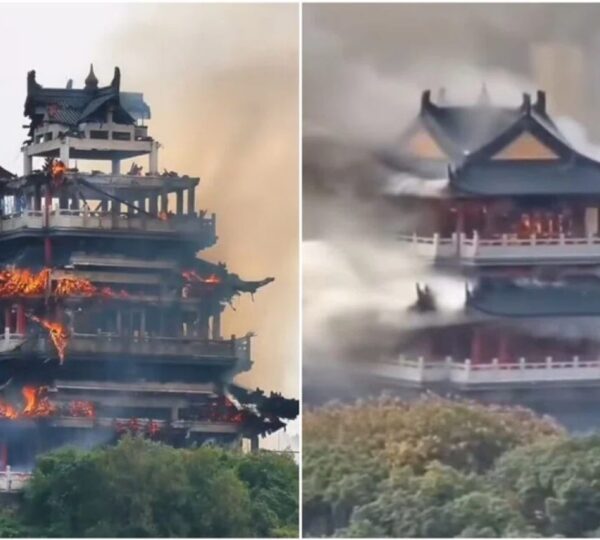
A Complete Structural Loss
Despite the best efforts of the firefighting teams, the Wenchang Pavilion was ultimately destroyed. The three-story building, once a striking landmark for visitors, collapsed inward as flames consumed its support beams and roof.
Footage showed:
-
the top floor disintegrating into ash,
-
carved decorative elements falling apart,
-
and bright orange flames continuing to burn until only charred remains were left standing.
It was a heartbreaking sight for the local community.
No Lives Lost — A Rare Relief
Although the structural loss was significant, authorities emphasized one crucial point:
no visitors, monks, or staff were injured.
Given the number of people usually present at the pavilion, this was considered a miracle of timing. If the fire had started later in the afternoon or during a festival period, the outcome could have been far worse.
Historical Significance Still Matters
While the pavilion itself was a modern reconstruction finished in 2009, it stood on a site with deep historical and cultural roots.
The broader temple area traces back over 1500 years, originally built during the Southern Liang dynasty. Throughout history, it has been referenced in poetry, literature, and religious writings. The famous Tang Dynasty poet Du Mu included the site among the “four hundred eighty glorious temples”—a line that still resonates in Chinese cultural memory.
Even more notably, the temple area is connected to Shi Nai’an, the author of Water Margin, one of the greatest classical Chinese novels. Historical records suggest he once lived and wrote in this section of the temple complex, lending a literary legacy that scholars still celebrate today.
Although the original structures no longer exist, the pavilion honored the legacy of both the ancient site and the scholars who once walked there.
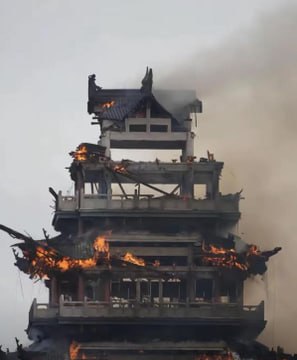
Emotional Reactions Flood Social Media
News of the fire triggered a wave of responses across Chinese social platforms such as Weibo, WeChat, and Douyin. Many expressed sadness and frustration, not only at the destruction but at the idea that a careless moment from a single tourist could lead to such a tragedy.
Comments included:
-
“A place of peace was destroyed by ignorance.”
-
“Cultural heritage requires respect, not recklessness.”
-
“This should be a lesson for all visitors.”
-
“I visited this pavilion last year… I can’t believe it’s gone.”
For the local community, the pavilion was not merely a tourist attraction—it was a spiritual and cultural symbol.
Officials Promise Stricter Safety Measures
Following the fire, authorities announced plans to:
-
increase fire-prevention signage,
-
improve surveillance systems,
-
restrict the use of incense and candles in certain areas,
-
and strengthen emergency protocols at all major cultural sites in the region.
The incident also renewed discussions about whether some temples should adopt electric candles or designated incense zones to reduce risk.
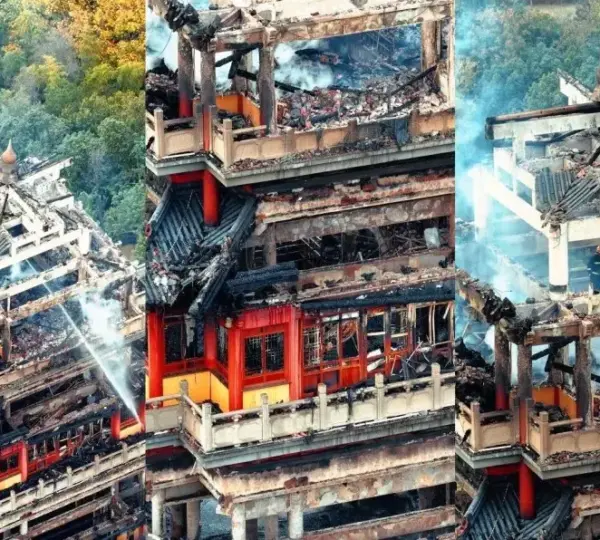
A Painful Reminder of a Similar Incident
This tragedy occurred only two years after a major fire at the Shandan Great Buddha Temple in Gansu province. That fire severely damaged surrounding structures and nearly destroyed a historic Buddha statue.
Together, these incidents highlight a growing concern:
historic and cultural sites are vulnerable, and even small mistakes can lead to catastrophic damage.
A Site Lost, but Legacy Lives On
Although the pavilion itself can be rebuilt, the emotional loss is real. Structures can be reconstructed, but the symbolism attached to them—the feeling of history, peace, and connection—cannot be replaced so easily.
The ashes of Wenchang Pavilion now serve as a powerful reminder of the importance of protecting cultural treasures, respecting spiritual spaces, and ensuring visitor responsibility.
In the days following the blaze, the charred remains of Wenchang Pavilion stood as a silent monument to the fragility of cultural spaces. Where once stood a vibrant structure filled with visitors, prayers, and the calm scent of incense, now lay a blackened skeleton—a visual reminder of how a single reckless act can dismantle years of cultural commitment and architectural planning.
The scene attracted hundreds of visitors, journalists, cultural historians, and curious onlookers. Some came out of sadness, wanting to witness the extent of the destruction. Others arrived seeking answers or simply to pay their respects to a place that had offered peace and spiritual grounding. Flowers were quietly placed near the standing stones. Incense was avoided entirely out of respect and caution. Silence often hung over the ruins as people stared at the ashes, absorbing the magnitude of what had been lost.
Investigators Work Through Ash and Debris
As the emotional reactions unfolded, investigation teams were already moving through the rubble. Wearing protective masks and stepping carefully over partially cracked concrete, forensic specialists examined every inch of the site. Their goal was to reconstruct the sequence of events in the clearest detail possible.
They mapped burn patterns, analyzed the direction and speed of flame spread, reviewed social-media videos frame by frame, and interviewed the visitor who allegedly mishandled the candle or incense. Officials also took statements from several eyewitnesses who had been near the pavilion at the time the fire began.
Early analysis suggested that the fire originated in an upper corner of the pavilion, where traces of melted wax were later found. This detail supported the initial theory that a candle or incense holder tipped or overheated. Investigators also noted that wind conditions at the time were unusually strong, causing embers to travel upward and outward, feeding the fire more rapidly than expected.
Although the building was made of concrete, interior trims, railings, banners, prayer cloths, and wooden decorative panels made it more susceptible to fast ignition. Once those inner surfaces caught fire, the flames moved quickly between floors.
The Broader Cultural Loss Beyond the Structure
Even though authorities confirmed no ancient relics were inside the pavilion, its symbolic loss remains profound. Cultural heritage is not solely defined by physical objects; it is tied to memory, identity, atmosphere, ritual, and community experience. For many people, the pavilion represented a connection to the mountain’s ancient past and the spiritual traditions that shaped the region.
Tour guides who had worked on Fenghuang Mountain for years expressed sorrow that they might never again point to the pavilion’s distinctive architecture. Monks who visited the site regularly reflected on how the pavilion had served as a meditative waypoint for generations. Local artisans who helped maintain the structure shared emotional messages online, describing their pain at seeing something they had once repaired or painted now reduced to ashes.
Some residents recalled visiting the pavilion with their grandparents, lighting incense during special holidays, or hiking to the summit for moments of quiet reflection. These memories cannot be rebuilt with concrete and scaffolding—they live in hearts, not in architecture.
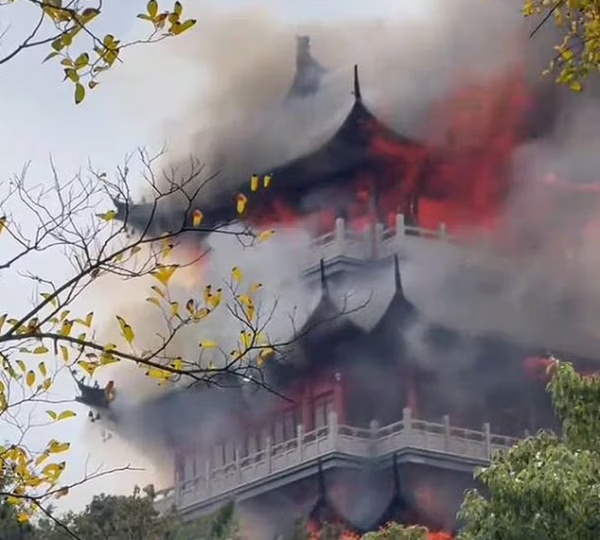
A National Conversation About Responsibility
The fire has also sparked important conversations across China regarding the responsibilities tourists bear when visiting cultural and religious sites. Many have pointed out that while tourism brings revenue and recognition, it also introduces risks when rules are ignored or misunderstood.
Social-media discussions turned into open forums about:
-
the need for clearer multilingual signs
-
stricter enforcement of incense and candle usage
-
mandatory fire-safety briefings at high-risk locations
-
the role of visitor education in preventing tragedies
Some regional officials have proposed requiring certain visitors to attend quick safety orientations before entering sacred areas, especially during peak seasons or religious festivals.
Calls for Modern Solutions in Ancient Spaces
In addition to education, many experts are calling for modern safety technology to be integrated into historic or sacred sites. Ideas include:
-
installing flame-retardant prayer cloths
-
using electric candles instead of traditional wax
-
creating designated safe-burning stations
-
adding temperature-sensitive sprinkler systems
-
installing discreet smoke sensors that blend into traditional architecture
These measures would allow cultural practices to continue while minimizing the risk of accidental fires.
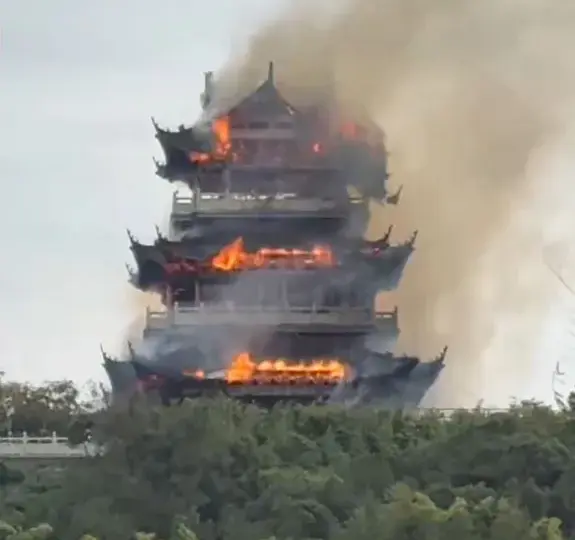
The Path Toward Reconstruction
Although emotionally painful, reconstruction discussions began almost immediately. Fenghuang Mountain holds too much spiritual and historical value for the community to leave the pavilion in ruins indefinitely. Local officials have already formed a committee tasked with planning the rebuilding process—one that may take months or even years to complete.
This committee will likely:
-
commission cultural architects
-
consult local historians
-
gather public feedback
-
ensure compliance with stricter fire-safety codes
-
and prepare a design that honors the original spirit of the structure
Many citizens have expressed a desire for the rebuilt pavilion to include educational displays about the fire, not to sensationalize the event, but to serve as a permanent reminder of why respecting sacred spaces is essential.
Economic Impact on the Region
Fenghuang Mountain attracts thousands of visitors annually. Restaurants, souvenir shops, tea houses, and guiding services depend heavily on tourism. While the fire did not affect the entire mountain, it may temporarily decrease foot traffic, especially among visitors who traveled specifically to see the pavilion.
Local business owners have voiced concerns about potential financial setbacks. However, city officials have reassured them that the mountain will remain open, that safety is being reinforced, and that tourism will continue—even while rebuilding plans are executed.
In fact, some experts believe the story of the fire may attract more visitors in the future, as people feel curious about the restoration process and want to witness the rebirth of the pavilion.
A Reflection on Preservation and Modern Life
The destruction of Wenchang Pavilion is more than a single event—it symbolizes the clash between ancient traditions and the realities of modern tourism. In a world where people carry phones, cameras, and candles up sacred mountains, mistakes travel fast and consequences spread even faster.
Heritage sites today must balance authenticity with protection. They must welcome visitors while safeguarding what makes them special. And they must find ways to honor the past without losing sight of contemporary safety needs.
This fire has reminded China—and the world—that cultural preservation is not passive. It requires active effort, responsibility, respect, and vigilance. Sacred spaces survive not just because they are beautiful, but because communities choose to care for them.
The Legacy That Survives the Flames
Though Wenchang Pavilion is gone, its spirit remains deeply embedded in the culture of the region. The stories connected to it, the poems referencing the ancient temples, the literary legacy tied to Water Margin, and the memories of generations who climbed Fenghuang Mountain remain untouched by fire.
Rebuilding will happen. Restoration will come. But more importantly, the lessons learned from the tragedy will shape the future—ensuring that sacred sites across the country become safer, stronger, and more protected for the generations that follow.
A Final Message of Reflection and Renewal
As the mountain slowly recovers from the shock of the blaze, its slopes remain quiet and dignified. The wind still moves through the trees. The paths still lead upward. And the community, united in memory and determination, prepares to rebuild—not just a pavilion, but a commitment to cultural respect.
In time, a new structure will rise where the ashes now rest. But the tragedy that brought it down will not be forgotten. Instead, it will serve as a lasting reminder:
heritage survives when people honor it, protect it, and treat it with the reverence it deserves.
What began as an ordinary, peaceful morning on Fenghuang Mountain in Jiangsu Province quickly transformed into a scene of fear, disbelief, and irreversible loss. A tranquil cultural site—visited daily by worshippers, hikers, and tourists—was suddenly engulfed in flames after a visitor’s careless act triggered a massive blaze at one of the region’s most cherished structures: the Wenchang Pavilion.
The incident, which occurred just after 11:00 a.m. local time, has captured nationwide attention, not only for the scale of the destruction but also for the underlying message about safety, responsibility, and the fragility of cultural heritage.
Although the pavilion itself was a modern reconstruction, the area it stands on carries centuries of history, with deep spiritual significance woven into every corner of Fenghuang Mountain.
A Quiet Morning Turns Into Chaos
For many visitors that day, it was supposed to be just another peaceful outing. The crisp mountain air, the gentle sound of wind moving through trees, and the slow footsteps of worshippers heading toward the pavilion gave the morning a sense of serenity.
But within minutes, everything changed.
Witnesses reported seeing thin white smoke drifting upward from the pavilion’s upper floor. At first, it was easy to dismiss—perhaps incense or a ceremonial offering. But the smoke quickly darkened, thickened, and expanded. What began as a faint trail soon transformed into a billowing cloud rising above the trees, signaling that something had gone terribly wrong.
By the time emergency services were alerted, flames were already visible inside the structure.

Firefighters Race Up the Mountain
When firefighters arrived, they faced a situation made far more difficult by the pavilion’s location. Perched on an elevated slope with narrow pathways and limited access for heavy equipment, reaching the fire required immediate coordination and precision.
Teams had to carry equipment manually up steep steps, fighting both the thick smoke and the increasing intensity of the flames.
Meanwhile, visitors and monks who had been on the mountain were quickly guided down to safety. Panic was visible in their movements—many looked back repeatedly, unable to believe that the pavilion could burn so violently. Some took photos or videos, and within moments, social media platforms across China began buzzing with posts about the unfolding disaster.
Several eyewitness recordings soon went viral, capturing:
-
large fireballs bursting through the structure
-
sections of the roof collapsing inward
-
explosions of sparks shooting into the sky
-
thick smoke filling the air like a black cloud
These videos helped authorities understand how quickly the fire spread and provided vital clues about its origin.
Authorities Identify the Suspected Cause
As emergency teams worked to contain the blaze, officials began an immediate investigation. Early findings pointed to a troubling conclusion:
a tourist had improperly used candles and incense inside or near the structure, violating site safety rules.
Traditional worship rituals often involve lighting incense or offering candles, but many cultural sites have strict guidelines about where these items may be used due to the extreme fire risk—especially in elevated pavilions surrounded by wooden materials, cloth banners, and decorative elements.
Authorities did not immediately release the identity of the visitor involved, but they confirmed that:
-
the fire likely began with an unattended or improperly placed candle,
-
the flames quickly ignited nearby materials,
-
and the structure’s design allowed the blaze to spread rapidly through the upper floors.
Although the pavilion was built with reinforced concrete, many interior elements—including wooden decorations—were highly flammable. The combination of wind on the mountain and the elevated position caused the fire to expand within minutes.

A Complete Structural Loss
Despite the best efforts of the firefighting teams, the Wenchang Pavilion was ultimately destroyed. The three-story building, once a striking landmark for visitors, collapsed inward as flames consumed its support beams and roof.
Footage showed:
-
the top floor disintegrating into ash,
-
carved decorative elements falling apart,
-
and bright orange flames continuing to burn until only charred remains were left standing.
It was a heartbreaking sight for the local community.
No Lives Lost — A Rare Relief
Although the structural loss was significant, authorities emphasized one crucial point:
no visitors, monks, or staff were injured.
Given the number of people usually present at the pavilion, this was considered a miracle of timing. If the fire had started later in the afternoon or during a festival period, the outcome could have been far worse.
Historical Significance Still Matters
While the pavilion itself was a modern reconstruction finished in 2009, it stood on a site with deep historical and cultural roots.
The broader temple area traces back over 1500 years, originally built during the Southern Liang dynasty. Throughout history, it has been referenced in poetry, literature, and religious writings. The famous Tang Dynasty poet Du Mu included the site among the “four hundred eighty glorious temples”—a line that still resonates in Chinese cultural memory.
Even more notably, the temple area is connected to Shi Nai’an, the author of Water Margin, one of the greatest classical Chinese novels. Historical records suggest he once lived and wrote in this section of the temple complex, lending a literary legacy that scholars still celebrate today.
Although the original structures no longer exist, the pavilion honored the legacy of both the ancient site and the scholars who once walked there.

Emotional Reactions Flood Social Media
News of the fire triggered a wave of responses across Chinese social platforms such as Weibo, WeChat, and Douyin. Many expressed sadness and frustration, not only at the destruction but at the idea that a careless moment from a single tourist could lead to such a tragedy.
Comments included:
-
“A place of peace was destroyed by ignorance.”
-
“Cultural heritage requires respect, not recklessness.”
-
“This should be a lesson for all visitors.”
-
“I visited this pavilion last year… I can’t believe it’s gone.”
For the local community, the pavilion was not merely a tourist attraction—it was a spiritual and cultural symbol.
Officials Promise Stricter Safety Measures
Following the fire, authorities announced plans to:
-
increase fire-prevention signage,
-
improve surveillance systems,
-
restrict the use of incense and candles in certain areas,
-
and strengthen emergency protocols at all major cultural sites in the region.
The incident also renewed discussions about whether some temples should adopt electric candles or designated incense zones to reduce risk.

A Painful Reminder of a Similar Incident
This tragedy occurred only two years after a major fire at the Shandan Great Buddha Temple in Gansu province. That fire severely damaged surrounding structures and nearly destroyed a historic Buddha statue.
Together, these incidents highlight a growing concern:
historic and cultural sites are vulnerable, and even small mistakes can lead to catastrophic damage.
A Site Lost, but Legacy Lives On
Although the pavilion itself can be rebuilt, the emotional loss is real. Structures can be reconstructed, but the symbolism attached to them—the feeling of history, peace, and connection—cannot be replaced so easily.
The ashes of Wenchang Pavilion now serve as a powerful reminder of the importance of protecting cultural treasures, respecting spiritual spaces, and ensuring visitor responsibility.
In the days following the blaze, the charred remains of Wenchang Pavilion stood as a silent monument to the fragility of cultural spaces. Where once stood a vibrant structure filled with visitors, prayers, and the calm scent of incense, now lay a blackened skeleton—a visual reminder of how a single reckless act can dismantle years of cultural commitment and architectural planning.
The scene attracted hundreds of visitors, journalists, cultural historians, and curious onlookers. Some came out of sadness, wanting to witness the extent of the destruction. Others arrived seeking answers or simply to pay their respects to a place that had offered peace and spiritual grounding. Flowers were quietly placed near the standing stones. Incense was avoided entirely out of respect and caution. Silence often hung over the ruins as people stared at the ashes, absorbing the magnitude of what had been lost.
Investigators Work Through Ash and Debris
As the emotional reactions unfolded, investigation teams were already moving through the rubble. Wearing protective masks and stepping carefully over partially cracked concrete, forensic specialists examined every inch of the site. Their goal was to reconstruct the sequence of events in the clearest detail possible.
They mapped burn patterns, analyzed the direction and speed of flame spread, reviewed social-media videos frame by frame, and interviewed the visitor who allegedly mishandled the candle or incense. Officials also took statements from several eyewitnesses who had been near the pavilion at the time the fire began.
Early analysis suggested that the fire originated in an upper corner of the pavilion, where traces of melted wax were later found. This detail supported the initial theory that a candle or incense holder tipped or overheated. Investigators also noted that wind conditions at the time were unusually strong, causing embers to travel upward and outward, feeding the fire more rapidly than expected.
Although the building was made of concrete, interior trims, railings, banners, prayer cloths, and wooden decorative panels made it more susceptible to fast ignition. Once those inner surfaces caught fire, the flames moved quickly between floors.
The Broader Cultural Loss Beyond the Structure
Even though authorities confirmed no ancient relics were inside the pavilion, its symbolic loss remains profound. Cultural heritage is not solely defined by physical objects; it is tied to memory, identity, atmosphere, ritual, and community experience. For many people, the pavilion represented a connection to the mountain’s ancient past and the spiritual traditions that shaped the region.
Tour guides who had worked on Fenghuang Mountain for years expressed sorrow that they might never again point to the pavilion’s distinctive architecture. Monks who visited the site regularly reflected on how the pavilion had served as a meditative waypoint for generations. Local artisans who helped maintain the structure shared emotional messages online, describing their pain at seeing something they had once repaired or painted now reduced to ashes.
Some residents recalled visiting the pavilion with their grandparents, lighting incense during special holidays, or hiking to the summit for moments of quiet reflection. These memories cannot be rebuilt with concrete and scaffolding—they live in hearts, not in architecture.

A National Conversation About Responsibility
The fire has also sparked important conversations across China regarding the responsibilities tourists bear when visiting cultural and religious sites. Many have pointed out that while tourism brings revenue and recognition, it also introduces risks when rules are ignored or misunderstood.
Social-media discussions turned into open forums about:
-
the need for clearer multilingual signs
-
stricter enforcement of incense and candle usage
-
mandatory fire-safety briefings at high-risk locations
-
the role of visitor education in preventing tragedies
Some regional officials have proposed requiring certain visitors to attend quick safety orientations before entering sacred areas, especially during peak seasons or religious festivals.
Calls for Modern Solutions in Ancient Spaces
In addition to education, many experts are calling for modern safety technology to be integrated into historic or sacred sites. Ideas include:
-
installing flame-retardant prayer cloths
-
using electric candles instead of traditional wax
-
creating designated safe-burning stations
-
adding temperature-sensitive sprinkler systems
-
installing discreet smoke sensors that blend into traditional architecture
These measures would allow cultural practices to continue while minimizing the risk of accidental fires.

The Path Toward Reconstruction
Although emotionally painful, reconstruction discussions began almost immediately. Fenghuang Mountain holds too much spiritual and historical value for the community to leave the pavilion in ruins indefinitely. Local officials have already formed a committee tasked with planning the rebuilding process—one that may take months or even years to complete.
This committee will likely:
-
commission cultural architects
-
consult local historians
-
gather public feedback
-
ensure compliance with stricter fire-safety codes
-
and prepare a design that honors the original spirit of the structure
Many citizens have expressed a desire for the rebuilt pavilion to include educational displays about the fire, not to sensationalize the event, but to serve as a permanent reminder of why respecting sacred spaces is essential.
Economic Impact on the Region
Fenghuang Mountain attracts thousands of visitors annually. Restaurants, souvenir shops, tea houses, and guiding services depend heavily on tourism. While the fire did not affect the entire mountain, it may temporarily decrease foot traffic, especially among visitors who traveled specifically to see the pavilion.
Local business owners have voiced concerns about potential financial setbacks. However, city officials have reassured them that the mountain will remain open, that safety is being reinforced, and that tourism will continue—even while rebuilding plans are executed.
In fact, some experts believe the story of the fire may attract more visitors in the future, as people feel curious about the restoration process and want to witness the rebirth of the pavilion.
A Reflection on Preservation and Modern Life
The destruction of Wenchang Pavilion is more than a single event—it symbolizes the clash between ancient traditions and the realities of modern tourism. In a world where people carry phones, cameras, and candles up sacred mountains, mistakes travel fast and consequences spread even faster.
Heritage sites today must balance authenticity with protection. They must welcome visitors while safeguarding what makes them special. And they must find ways to honor the past without losing sight of contemporary safety needs.
This fire has reminded China—and the world—that cultural preservation is not passive. It requires active effort, responsibility, respect, and vigilance. Sacred spaces survive not just because they are beautiful, but because communities choose to care for them.
The Legacy That Survives the Flames
Though Wenchang Pavilion is gone, its spirit remains deeply embedded in the culture of the region. The stories connected to it, the poems referencing the ancient temples, the literary legacy tied to Water Margin, and the memories of generations who climbed Fenghuang Mountain remain untouched by fire.
Rebuilding will happen. Restoration will come. But more importantly, the lessons learned from the tragedy will shape the future—ensuring that sacred sites across the country become safer, stronger, and more protected for the generations that follow.
A Final Message of Reflection and Renewal
As the mountain slowly recovers from the shock of the blaze, its slopes remain quiet and dignified. The wind still moves through the trees. The paths still lead upward. And the community, united in memory and determination, prepares to rebuild—not just a pavilion, but a commitment to cultural respect.
In time, a new structure will rise where the ashes now rest. But the tragedy that brought it down will not be forgotten. Instead, it will serve as a lasting reminder:
heritage survives when people honor it, protect it, and treat it with the reverence it deserves.
